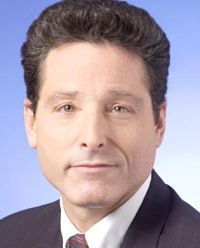 Corporate dividends have flourished recently, but a cominghike in the federal tax on dividends could discourage the renewedcorporate interest in making dividend payments.
Corporate dividends have flourished recently, but a cominghike in the federal tax on dividends could discourage the renewedcorporate interest in making dividend payments.
While dividends took a beating in 2008 and 2009 in the wake ofthe financial crisis, “they have now come back and set a brand newrecord,” says Howard Silverblatt, senior index analyst at S&PDow Jones Indices. He expects S&P 500 companies to pay a record$276 billion in dividends this year, surpassing the previous recordof $248 billion paid in 2008.
|Silverblatt, pictured at left, notes that 400 of theS&P 500 companies currently pay dividends, the highest levelsince 1999, and predicts almost 70% of those that paydividends will increase their payments this year. Ten S&P500 companies initiated dividends so far this year, including techgiants Apple and Dell, following the 22 companies that did so in2011.
|By historical standards, companies are still not being thatgenerous, though. S&P 500 companies currently pay dividendsequal to 31% of their reported earnings, which falls far short ofthe historical average of 54% since 1936.
|Silverblatt links the pick-up in dividend payments with theimprovement in corporate earnings. “Dividends trail earnings,”Silverblatt says. “Companies like to see several quarters of decentearnings and then they start increasing [the dividend].”
| Companies currently have a lot of cash on their balancesheets, but Josh Peters, editor of Morningstar DividendInvestor,says big cash holdings “tend to make managers think more in termsof a share repurchase program, perhaps a special dividend or anacquisition. Regular dividends are not really how you deal with acash pile-up.”
Companies currently have a lot of cash on their balancesheets, but Josh Peters, editor of Morningstar DividendInvestor,says big cash holdings “tend to make managers think more in termsof a share repurchase program, perhaps a special dividend or anacquisition. Regular dividends are not really how you deal with acash pile-up.”
Peters, pictured at right, also notes the demographic shiftthat's occurring. Baby boomers preparing to retire are much lesslikely than their parents to have a defined-benefit pension andthey're less confident that stocks will post a healthy return everyyear. “You need that dividend that you can depend on,” he says. “Asindividual investors realize that dividends are much more importantthan they thought back in the '90s, you're starting to see someinstitutional investors take more of an interest and in turn,companies are taking note.”
|But unless Congress intervenes, the tax on dividend income isscheduled to rise from the current 15% to a maximum rate of 43.4%at the end of this year. “If you pay me a dollar dividend Dec. 31,I get to keep 85 cents,” Silverblatt says. “If you pay me Jan. 1,it's under 57 cents.”
|He argues that in the current low-interest-rate environment,investors will see dividend payments as attractive even at thehigher tax rate. “Investors do not have a lot of alternatives.” Andof course, many investors hold shares in tax-advantaged accountssuch as 401(k)s or IRAs.
|Companies are another matter. “Companies aregoing to look at [the higher tax rate] and say, 'Should I beincreasing my normal dividend at this rate if my holders don't getto keep as much?'” Silverblatt says. “We don't think anyone willsay, 'I'm not going to pay,' but some companies might divert somemoney from dividends to buybacks. It will put some pressure ondividends and probably add to buybacks.”
|He also expects some companies that are scheduled to makedividend payments next January to try to shield shareholders fromthe tax hike by making those payments late this year, a practice hecalls Q5 payments. U.S. companies paid $21 billion in qualifieddividends in January 2012, Silverblatt notes. “Companies that payin January are going to move up those payments and pay inDecember.”
|Morningstar's Peters argues that the tax increase won't altercompanies' dividend practices, and cites General Mills, which hasbeen paying a dividend without interruption for 113 years. “Itsindividual shareholders are certainly counting on getting thosedividends and seeing those dividends grow,” he says. “If dividendtaxes go up, I don't think that's going to change [General Mills']dividend policy.”
|The scenario might be different for companies that only startedpaying a dividend recently, Peters says. “What you may see is thatcompanies with immature dividend policies, that maybe have onlystarted paying dividends over the last eight to nine years, when wehad low tax rates, may say, 'Oh, so we're taking the dividendaway.'”
|Anjolein Schmeits, clinical professor of finance at New YorkUniversity's Stern School of Business, says companies have paid outmore dividends since President George W. Bush lowered the dividendtax rate to match the rate on capital gains. “But that alsocoincided with higher corporate profits.”
|Whether it's best for companies to make payments to shareholdersin the form of dividends or stock repurchases “will definitely beaffected by taxes,” Schmeits says. “But corporate profits areanother important factor that impact dividend payments,clearly.”
|See a slideshow highlighting some S&P 500 companies that paydividends.
|Complete your profile to continue reading and get FREE access to Treasury & Risk, part of your ALM digital membership.
Your access to unlimited Treasury & Risk content isn’t changing.
Once you are an ALM digital member, you’ll receive:
- Critical Treasury & Risk information including in-depth analysis of treasury and finance best practices, case studies with corporate innovators, informative newsletters, educational webcasts and videos, and resources from industry leaders.
- Exclusive discounts on ALM and Treasury & Risk events.
- Access to other award-winning ALM websites including PropertyCasualty360.com and Law.com.
*May exclude premium content
Already have an account? Sign In
© 2024 ALM Global, LLC, All Rights Reserved. Request academic re-use from www.copyright.com. All other uses, submit a request to [email protected]. For more information visit Asset & Logo Licensing.







